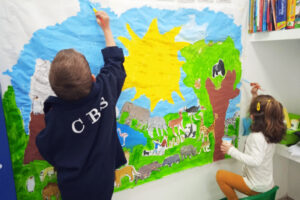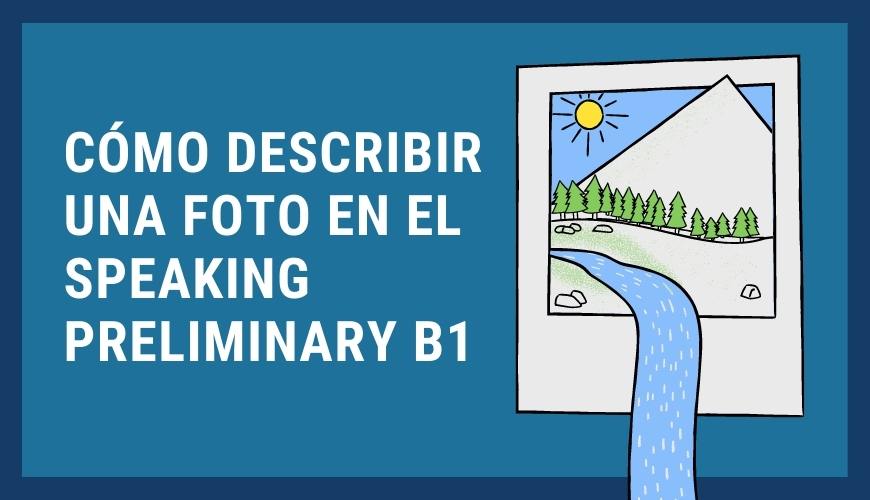
Cómo describir una foto en el Speaking Preliminary B1
Describir una foto en inglés suele ser una de las tareas que se piden en la parte del Speaking de los exámenes de Cambridge. Estar preparado para esta tarea es básico para poder mantener el control, estar seguros y… ¡bordarlo el día del examen!
Hoy te queremos mostrar unos pasos muy simples para describir una foto en inglés ¡con éxito!
Parte 1: Describe lo que ves en la foto.
Este paso trata de describir de forma muy general lo que ves en la fotografía. Consiste sólo en decir una frase que incluya: ¿Qué ves, qué personas hay y dónde están? Esta parte tiene que ser muy simple, es más bien una frase introductoria y general de lo que hay en la fotografía. Utiliza el presente simple.
Algunas expresiones útiles:
|
|
|
|
|
|
|
Paso 2: habla sobre dónde está cada cosa.
En esta parte no hay que esmerarse mucho, simplemente habla de las cosas que tengan relevancia. No hace falta comentar cada detalle de todo lo que hay en la fotografía.
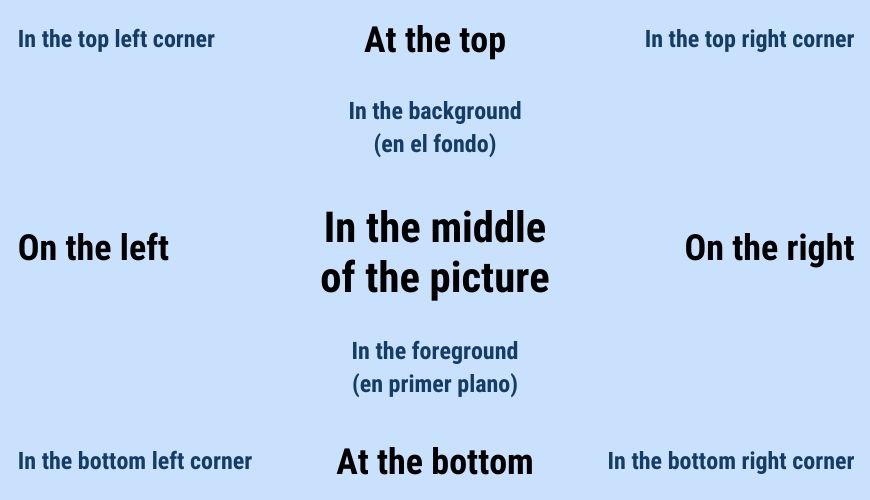
Para esta parte, también conviene usar las preposiciones de lugar:
| at the top | in the middle of / in the centre of the picture |
| in the distance | behind / in front of / between / next to |
| On top of…/ Under… | in the picture on the left / right |
| Next to… / Near… | Behind… / In front of… |
| in the foreground / background | at the bottom / on the right corner |
El segundo consejo o paso es empezar a entrar en detalles. Te dejamos algunos ejemplos que puedes utilizar:
Posición y localización:
|
|
|
|
|
|
|
Paso 3: Describe las personas de la foto
Qué llevan puesto? ¿Qué están haciendo? ¿Cómo son físicamente?
Para describir lo que las personas llevan puesto y lo que están haciendo hay que utilizar el presente continuo:
The girl is wearing a white dress.
They are playing a board game.
Para describir las características físicas hay que utilizar el presente simple.
Paso 4: Describe el lugar.
¿Qué tiempo hace? ¿Están dentro o fuera? ¿Es campo o ciudad? ¿Cómo es el sitio?
Algunas expresiones útiles:
|
|
|
|
Paso 5: Haz suposiciones.
Este sería el último paso. Una vez que describes todo lo que puedes ver, ¡toca dar rienda suelta a tu imaginación! ¿Cómo crees que se sienten las personas? ¿Por qué crees que están ahí? ¿Crees que son familia o amigos?
Siempre que hagas especulaciones, es importante explicar el por qué piensas tal cosa.
Este paso también puedes incluirlo en otros pasos. Es decir, no hay que dejarlo exclusivamente para el final. Por ejemplo, si estás describiendo las cosas que hay encima de una mesa y no sabes lo que es algo, puedes especular.
Algunas expresiones útiles:
| Probably… | It might… |
| It could… | Perhaps / Maybe… |
| I think… | I believe… |
| It looks like… | It seems… |
Comparación (si hay dos fotografías)
Si la instrucción el día del examen es la de comparar las fotografías no pierdas el tiempo describiéndolas. Haz lo que te piden. Te dejamos con algunos ejemplos que puedes utilizar:
Comparar – hablar de parecidos:
| Both pictures show… | In both pictures there is / there are… |
| …the same as… | …similar to… |
| …as (adjective) as… |
Contrastar – hablar de las diferencias:
| The first picture shows…but/whereas/while the other one shows… | One of these pictures shows…while the other shows… |
| Although the first picture is… the second picture… | …different from… |
| …not as (adjective) as… |
Comparaciones:
| …more than… | …looks more peaceful than… |
| …much more / a lot more… | …slightly more / a little bit more… |
EJEMPLO 1
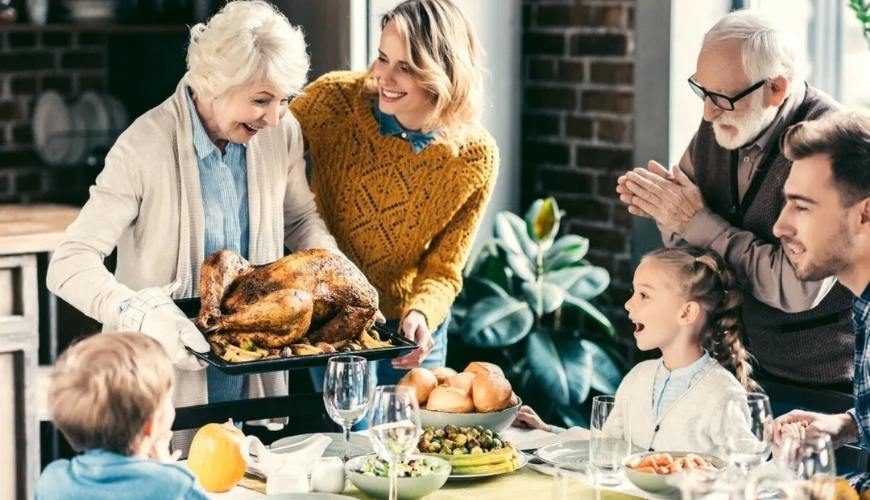
This picture shows (1) a group of people having dinner. I can see(1) two elderly people, two children and two middle-aged people. They are probably (5) a family because they look similar to each other. In the foreground (2), I can see the dinner table and the woman on the left (2) is carrying a turkey. Next to (2) her, another woman is helping her with the turkey. On (2) the table there is some bread and other dishes, some glasses and some plates. The people are wearing (3) winter clothes and they are looking at (3) the turkey. They are indoors (4) and the place looks beautiful and bright (4). This place looks like (5) the interior of a house. I think (5) they are having a family reunion and they seem(5) to be enjoying their time together because (5) they are smiling.
EJEMPLO 2
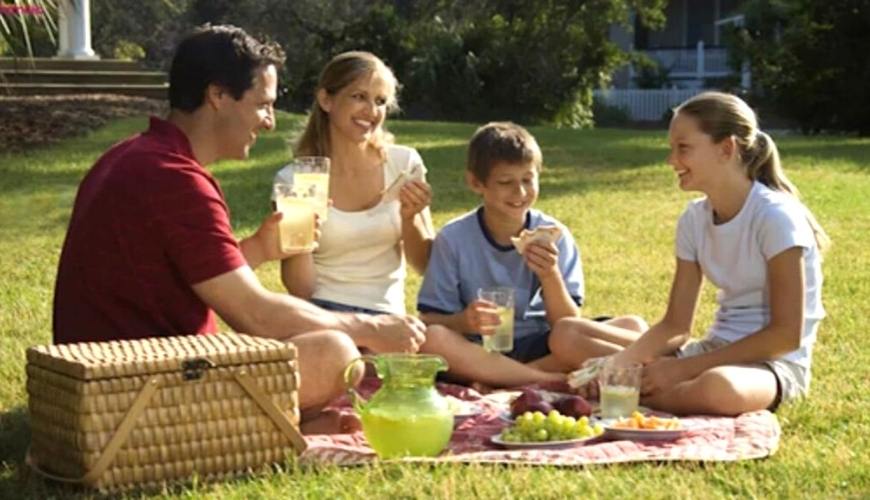
In this picture I can see a family having a picnic. They are eating some fruit and drinking some juice. They are in a garden in front of a house. The parents are in their thirties, their son is around 10 years old and their daughter is a teenager. The photo was taken in summer because they are wearing t-shirts and shorts and it’s sunny. In the bottom left corner there is a basket and in the background I can see some trees. They seem to be having a good time. It looks like a peaceful place.
CONSEJOS GENERALES DEL SPEAKING
- Usa el presente simple y el presente continuo: todo lo que describes tiene que estar en presente, ya que es lo que estás viendo en este momento. La foto no puede estar en pasado o en futuro.
- Usa adjetivos descriptivos: esto te ayudará a enriquecer tu nivel de speaking y te resultará muy útil para describir personas y lugares.
- Si no estás segur@ de cómo se dice algo no te agobies ni te empeñes en acordarte. Busca una palabra con un significado parecido o trata de describir la palabra.
- NO hay que utilizar estos pasos por orden. Puedes mezclarlos si los ves conveniente.
